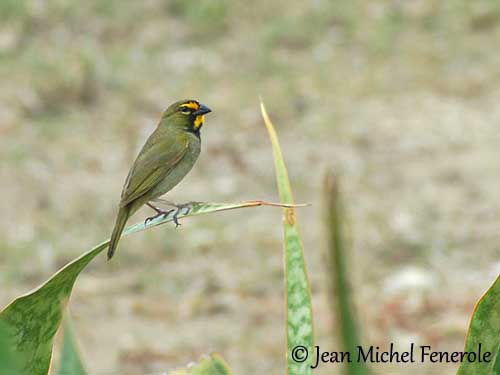
Fr: Sporophile Grand-chanteur
Ang: Yellow-faced Grassquit
All: Goldbrauen-Gimpelfink
Esp: Semillero Tomeguín - Gorrión Barba Amarilla (Puerto Rico)
Ita: Fringuello cantore facciagialla
Nd: Grote Cubavink
Sd: Större kubafink
Photographers:
Roger Ahlman
Pbase Galleries Peru and Ecuador
Jean Michel Fenerole
Photos d’Oiseaux du monde
Ken Havard
My Bird Gallery & Flickr gallery 1 & Flickr gallery 2
Text by Nicole Bouglouan
Sources :
HANDBOOK OF THE BIRDS OF THE WORLD Vol 16 by Josep del Hoyo- Andrew Elliot-David Christie – Lynx Edicions – ISBN: 9788496553781
A GUIDE TO THE BIRDS OF MEXICO AND NORTHERN CENTRAL AMERICA by Steve N. G. Howell, Sophie Webb - Oxford University Press - ISBN: 0198540124
A GUIDE TO THE BIRDS OF COLOMBIA by Steven L. Hilty and William L. Brown - Princeton University Press – ISBN 069108372X
BirdLife International (BirdLife International)
Neotropical Birds – Cornell Lab of Ornithology
What Bird-The ultimate Bird Guide (Mitchell Waite)
Wikipedia, the free encyclopaedia
The Guardian - Mystery bird: Yellow-faced Grassquit, Tiaris olivaceus
Yellow-faced Grassquit
Tiaris olivaceus
Passeriformes Order – Thraupidae Family
INTRODUCTION:
Formerly placed in the family Emberizidae, the Yellow-faced Grassquit is now included in the family Thraupidae. The genus Tiaris is part of the clade of specialized tanagers and it is closely related to Darwin’s Finches and several Caribbean genera. This group is defined as the “domed nest clade” and named Tholospiza or Tholospizan finches.
The relationships were defined by DNA analysis, but the members of this group also share the nest type, the island habitat and the adaptability of bill morphology.
DESCRIPTION OF THE BIRD:
Biometrics:
Length: 9-11,5 cm
Weight: 6-10 g
The adult male of nominate race has olive upperparts including wings and tail.
On the underparts, the breast is blackish with pale olive-grey sides and rest of underparts.
On the head, the face is blackish. Supercilium, chin and throat are orange-yellow. We can see a pale yellowish crescent below the eye.
The conical bill is blackish. The eyes are dark brown. Legs and feet are dark grey.

T.o. olivaceus
Male
The female resembles male but she is duller, mostly greenish. Supercilium, chin and throat patches are much paler.
The juvenile resembles female with greyer and duller appearance.
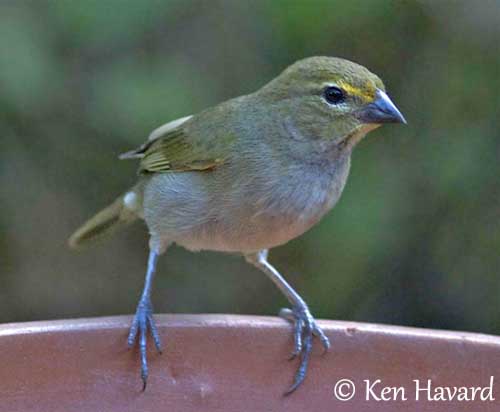
T.o. olivaceus
Juvenile
SUBSPECIES AND RANGE:
The Yellow-faced Grassquit has five recognized subspecies.
T.o. pusillus (displayed) is found on the Atlantic slope of Mexico, S through Central America but locally, Colombia (W of E Andes except Santa Marta region), and NW and E Ecuador and W Venezuela.
In this race, the male has black more extensive on breast. Ear-coverts and crown can be black too.
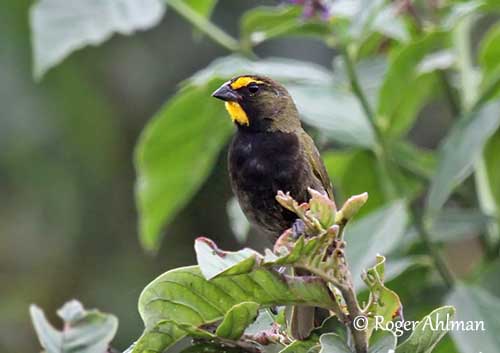
T.o. pusillus
Male
T.o. intermedius occurs on Cozumel Island in E Yucatan.
This one is larger than nominate with black on breast more extensive in male.
T.o. ravidus is found on Coiba Island in W Panama.
This race is darker than “pusillus”. Black on male extends to nape and below, to belly.
T.o. olivaceus (described and displayed) occurs in Cuba, Isle of Pines, Cayman Islands, Jamaica and Hispaniola.
T.o. bryanti occurs in Puerto Rico and adjacent islands.
This one resembles nominate but it is smaller, with brighter olive-green upperparts and more yellowish on underparts.
HABITAT:
The Yellow-faced Grassquit frequents humid to semi-arid open habitats including second growths, forest edges, clearings, wet pastures, roadsides, thickets, weedy fields with scattered shrubs and trees, gardens and overgrown lawns. This species occurs from lowlands up to 2000 metres of elevation.
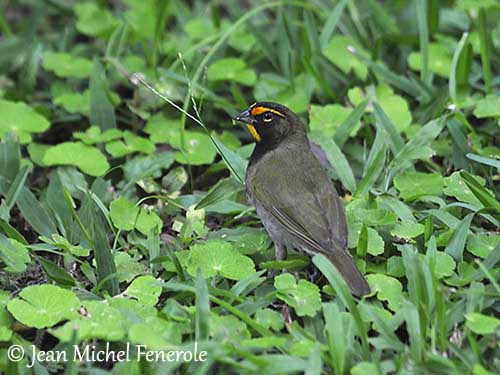
T.o. pusillus
Male
CALLS AND SONGS: SOUNDS BY XENO-CANTO
The Yellow-faced Grassquit gives high-pitched “sik” or “tsi”. The song is a rapid, high-pitched, often soft, insect-like trill “siiiiiiiiiir” or “tttttt-tee” and variants such as a slower “siiiriririr”. This song is given from low perch and usually starts at the beginning of the rainy season.
BEHAVIOUR IN THE WILD:
The Yellow-faced Grassquit is almost exclusively seedeater and takes seeds from various grass species, but especially Paspalum and Panicum. When the grass seeds become scarce, it also takes berries and insects, and forages in trees like Parulidae species.
It feeds on seeds on the ground and by climbing to the stems. It also sips nectar from flowers.
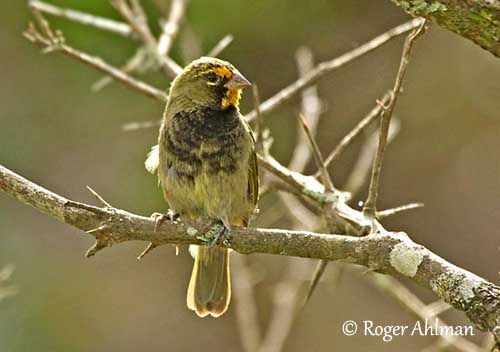
T.o. pusillus
Male
It is usually seen in pairs or singly, but it also forages in mixed flocks with other seedeaters such as the Blue-black Grassquit.
During the breeding season, the male performs courtship displays. It sings while vibrating its raised wings, a few centimetres in front of the female. This display is still performed after mating and usually until the nest-building. They are monogamous.
The Yellow-faced Grassquit is sedentary and only performs short, dispersive movements. It has occurred as vagrant in S Texas and in Florida.
It performs a short, weak fluttering flight with series of rapid wingbeats interspersed with wings pulled in to the sides. The flight is short and buzzy.
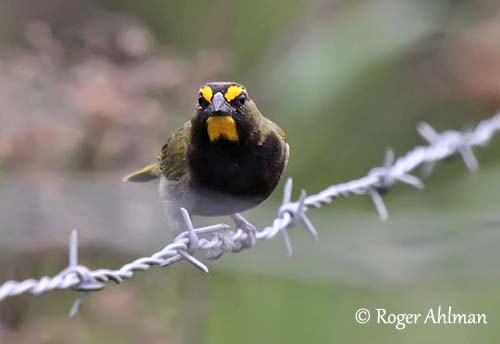
T.o. pusillus
Male
REPRODUCTION OF THIS SPECIES:
The breeding season varies according to the range. The Yellow-faced Grassquit may breed throughout the year in Cuba and probably in all months in rest of West Indies, except between February and April. This species is solitary nester.
The nest is built by both adults in grass tussock or in low bush, between 20 and 150 centimetres above the ground.
It is a domed, ovoid nest with a side entrance. It is made with thickly woven dry grasses, straw and weed stems. The inner cup is lined with finer pieces of grasses and fibres. Such nest can be 14 cm high by 7-8 cm in diameter. Nest-building takes 3-6 days.
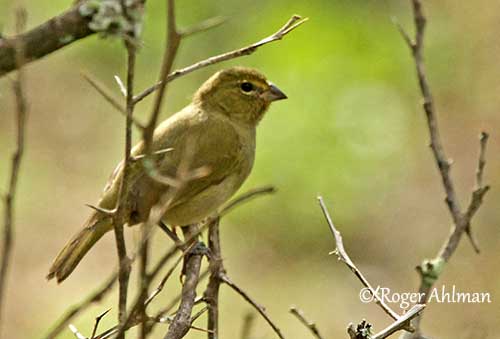
T.o. pusillus
Female
The female usually lays 2-3 pale blue eggs with brown markings. She incubates alone during 12-14 days. The chicks are fed by both parents on regurgitated seeds.
PROTECTION / THREATS / STATUS:
The Yellow-faced Grassquit is common in suitable habitat. This species has wide range and the population is suspected to be increasing. It benefits from degradation of the habitat, involving new suitable areas.
The Yellow-faced Grassquit is not currently threatened and evaluated as Least Concern.
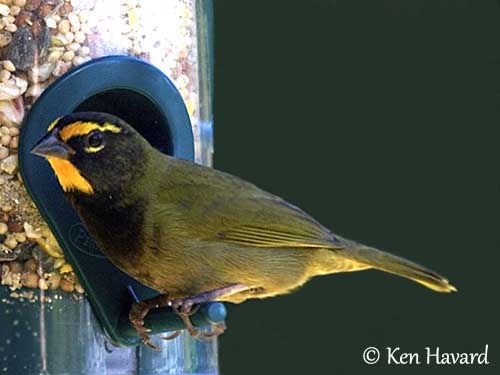
T.o. pusillus
Male